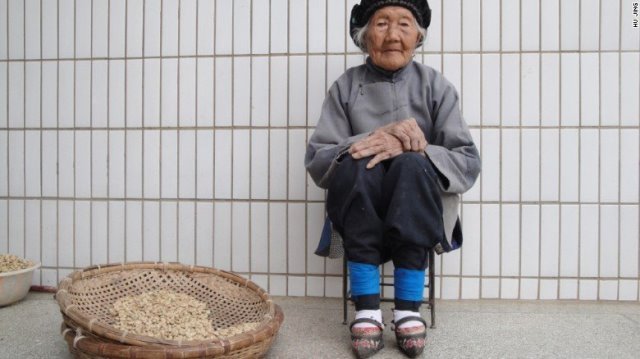It was an excruciatingly painful practice that maimed the feet of millions of Chinese girls and women for centuries: foot-binding.
Tiny “golden lotus” feet — achieved through breaking girls’ toes and arches and binding them to the sole of the foot with cloth — were thought to be a passport to a better marriage and a better way of life.
“In the conventional view, it existed to please men. They were thought to be attracted to small feet,” said Laurel Bossen, co-author of the new book “Bound feet, Young hands.”
But Bossen’s research suggests that the custom has been massively misunderstood.
Girls who had their feet bound didn’t lead a life of idle beauty but rather served a crucial economic purpose, especially in the countryside, where girls as young as 7 weaved, spun and did work by hand, Bossen said.
Foot-binding persisted for so long because it had a clear economic rationale: It was a way to make sure young girls sat still and helped make goods like yarn, cloth, mats, shoes and fishing nets that families depended upon for income — even if the girls themselves were told it would make them more marriageable.
Bossen says women weren’t shy about talking about or showing their bound feet, making her skeptical that it was an erotically charged fetish.
‘Distortion of history’
“You have to link hands and feet. Footbound women did valuable handwork at home in cottage industries. The image of them as idle sexual trophies is a grave distortion of history,” said Bossen.
Foot-binding persisted because it ensured that young girls sat still and worked at a boring, sedentary task for many hours each day, she said, and it died out only when manufactured cloth and foreign imports eliminated the economic value of handwork.
Bossen, professor emerita of anthropology at McGill University in Montreal, and Hill Gates, who holds the same post at Central Michigan University, interviewed just under 1,800 elderly women in several locations across rural China — the last generation to have bound feet — to pinpoint when and why the practice began to decline.
They found that foot-binding endured longest in areas where it still made economic sense to produce goods like cloth at home and began to decline only when cheaper factory-made alternatives became available in these regions.
Girls began hand spinning yarn as young as 6 or 7 — roughly the same ages as when their feet were bound. The women they spoke to made the connection between the two:
“My mother bound my feet when I was around 10 years. At around age 10, I started to spin cotton. Each time she bound my feet, it hurt until I cried,” one woman who was born in 1933 told the researchers.
Foot-binding dates to the Song dynasty (960-1279) and spread from court circles to wealthy elites and eventually from the city to the countryside. By the 19th century, it was commonplace across China.
It began to decline in the early years of the 20th century, with its demise usually attributed to ideological campaigns led by missionaries and reformers, and subsequent moves by the Nationalist government followed by the Communists to ban the practice.
Bossen said she spoke to women born as late as the 1940s whose feet had been bound for a short time.
Lessons for fight against genital cutting?
Bossen said her research offers lessons for the modern fight against other customs that are damaging to women and girls — such as female genital mutilation, or FGM.
Some academics like Gerry Mackie and Kwame Anthony Appiah have drawn lessons about the eradication of foot-binding and tried to apply them to genital cutting. They believe FGM could be eradicated by educational campaigns and forming groups to explain the damage done by the practice.
But Bossen said they might be drawn to the wrong course of action. Her research suggests it was economic factors not campaigns waged by religious groups and reformers that ultimately sounded the death knell for bound feet.
“It’s harder to see an economic side to (genital cutting),” she said. “But you cannot look at foot-binding and conclude that an ideological campaign will be effective.”



